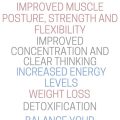Unlocking the Power of Yoga Beyond Physical Exercise: A Holistic Approach to Wellness
When people think of yoga, the first image that often comes to mind is someone performing complex poses on a mat. However, yoga is far more than just physical exercise. In fact, the roots of yoga encompass a wide array of practices aimed at uniting the body, mind, and spirit. In this article, we explore the transformative aspects of yoga that do not require intense physical activity, yet still offer profound benefits to overall wellness. Whether you’re a beginner or an advanced practitioner, the multidimensionality of yoga offers something for everyone.
Key Concepts of Non-Physical Yoga Practices
Understanding yoga beyond the body requires familiarity with its foundational concepts. Yoga without physical exercise focuses on the mental, emotional, and spiritual dimensions of the practice. Some of the key non-physical components include:
- Pranayama: The practice of breath control, which is central to managing energy and mental clarity.
- Mantra Meditation: Repetition of sacred sounds or words to focus the mind and elevate consciousness.
- Jnana Yoga: A path of wisdom and self-inquiry that seeks to uncover deep truths about the self and the universe.
- Karma Yoga: A practice of selfless service that emphasizes action without attachment to outcomes.
- Bhakti Yoga: The cultivation of love and devotion towards a higher power or principle.
Historical Context: Yoga’s Evolution Beyond Physical Postures
Yoga’s history stretches back over 5,000 years, originating in India as a holistic system that included physical, mental, and spiritual practices. Early texts like the Upanishads and the Bhagavad Gita describe yoga as a comprehensive lifestyle, not just as a set of poses. In fact, asana, or physical postures, are just one of the Eight Limbs of Yoga, as outlined by the sage Patanjali in the Yoga Sutras.
While modern yoga in the West has often emphasized asana practice, the original intent was to achieve mental clarity and spiritual awakening. Over the centuries, various schools of yoga, such as Raja Yoga, emphasized practices like meditation, concentration, and ethical conduct as the true core of yoga.
Current State of Yoga Practices Without Exercise
Today, there is a growing awareness of yoga’s potential to support mental health and emotional well-being without the need for vigorous physical activity. Many modern practitioners are turning to meditative practices, breathwork, and philosophical study to reap yoga’s benefits. Non-physical yoga practices are particularly valuable for:
- Individuals with limited mobility or physical disabilities
- People seeking stress relief or improved mental clarity
- Those interested in exploring yoga’s spiritual and philosophical dimensions
- Busy professionals looking for accessible, non-physical practices to enhance mindfulness
Yoga apps, virtual classes, and mindfulness programs increasingly offer guided meditation, pranayama sessions, and philosophical discussions, creating a more inclusive approach to yoga.
Practical Applications of Non-Physical Yoga
Incorporating yoga into daily life doesn’t require a yoga mat or physical flexibility. Here are several ways to practice yoga without breaking a sweat:
- Morning Pranayama: Start the day with simple breathing exercises like Nadi Shodhana (alternate nostril breathing) to promote balance and calm.
- Meditation Breaks: Take five-minute meditation breaks during the workday to center the mind and reduce stress.
- Mindful Listening: Practice listening with full attention and without judgment as a form of Karma Yoga.
- Journaling: Engage in reflective writing to explore self-awareness and deepen the practice of Jnana Yoga.
Case Studies: The Impact of Non-Physical Yoga Practices
Let’s take a look at real-life examples of how people have benefited from non-physical yoga:
| Case Study | Challenge | Yoga Practice | Outcome |
|---|---|---|---|
| Alice, a 45-year-old executive | High stress and burnout from a demanding job | Daily pranayama and mindfulness meditation | Improved mental clarity, reduced stress levels, and better emotional balance |
| John, a 60-year-old retiree | Limited mobility due to arthritis | Mantra meditation and guided visualization | Heightened sense of peace and reduced anxiety about physical limitations |
| Sarah, a 30-year-old teacher | Difficulty managing work-life balance | Karma yoga through volunteer work and mindful presence with students | Felt more grounded and connected in both personal and professional life |
Stakeholder Analysis: Who Benefits from Non-Physical Yoga?
Yoga beyond physical exercise offers benefits to a variety of stakeholders:
- Healthcare Providers: Can incorporate pranayama and mindfulness as part of mental health treatment plans.
- Corporate Wellness Programs: Can offer meditation and stress-relief techniques to improve employee well-being.
- Educational Institutions: Can teach students yoga philosophy and mindfulness to support emotional regulation.
- Community Leaders: Can use non-physical yoga practices to promote inclusivity and holistic wellness in public programs.
Implementation Guidelines: How to Start Practicing Non-Physical Yoga
Implementing non-physical yoga practices in daily life can be simple and effective. Here’s a step-by-step guide:
- Start with breath awareness by observing your breath for five minutes a day.
- Choose a mantra or phrase that resonates with you and repeat it during meditation.
- Set aside time each day to reflect on your thoughts and actions through journaling or mindful inquiry.
- Integrate service into your life by volunteering or helping others without expectation of reward.
Ethical Considerations in Non-Physical Yoga
While non-physical yoga offers numerous benefits, there are ethical considerations to keep in mind:
- Cultural Appropriation: Be mindful of yoga’s cultural origins and practice with respect for its history and spiritual roots.
- Spiritual Bypassing: Avoid using yoga as a way to bypass difficult emotions or avoid personal responsibility.
- Commercialization: Ensure that yoga programs and products promote genuine well-being rather than exploiting its popularity for profit.
Limitations and Future Research
While non-physical yoga offers many benefits, more research is needed to fully understand its potential and limitations. Some of the areas that require further exploration include:
- The long-term mental health benefits of practices like mantra meditation and pranayama
- The effectiveness of non-physical yoga for different age groups and populations, such as individuals with chronic illness
- Comparative studies between traditional meditation techniques and modern mindfulness practices
Future research should also focus on creating standardized protocols for incorporating non-physical yoga into mental health treatments and wellness programs.
Expert Commentary on Yoga Beyond Exercise
Experts agree that non-physical yoga practices provide invaluable tools for stress management, emotional well-being, and spiritual growth. As Dr. Amina Patel, a yoga scholar, notes: “The true power of yoga lies not in how far we can stretch our bodies, but in how deeply we can quiet our minds and open our hearts.”
As more people explore yoga’s deeper dimensions, it becomes clear that this ancient practice holds far more than meets the eye. Non-physical yoga can transform lives, no matter the limitations one might face physically. The future of yoga is more inclusive, accessible, and meaningful than ever before.








